Impatiens are a favorite, old-fashioned garden plant that has been updated by plant breeders to include neon colors and colorful foliage.
There are about 850 Impatiens species including annuals, perennials, and subshrubs. All have brittle, succulent stems, fleshy leaves, and spurred asymmetrical flowers. Each flower has five petals; the lower two petals are fused together or form a lobed pair. Flowers can be single or double.
Balsam, Impatiens balsamina, is a summer annual with pink, red, lilac, and white flowers that resemble miniature double camellias. Balsam grows from 10 to 30 inches (25-76cm) tall.
Busy Lizzie, Imptiens walleriana, is a tender perennial usually grown as an annual. It brings bright color to shade gardens—flowers are red, pink, rose, violet, orange, white, and bi-colors. Dwarfs are 4 to 8 inches (10-20cm) tall; full-size varieties grow to 2 feet (61cm) tall.
New Guinea hybrids are bred from species from New Guinea. Flower colors include red, orange, pink, lavender, and purple; leaves are often striped with red or yellow. Plants grow 8 to 24 inches (20-61cm) tall. New Guineas are a colorful choice for pots.
Good Products for Growing Your Garden:
- 55 Heirloom Vegetable Varieties–27,500 Non GMO Seeds
- Heirloom Vegetable Seed Collection – 105 Varieties
- Galvanized Raised Garden Bed with Cover
- Gardzen 10-Pack 10 Gallon Grow Bags
- Captain Jack’s Dead Bug Brew
- Harris Neem Oil Plant Disease Control
- Freeze Protection Garden Mesh Netting Kit
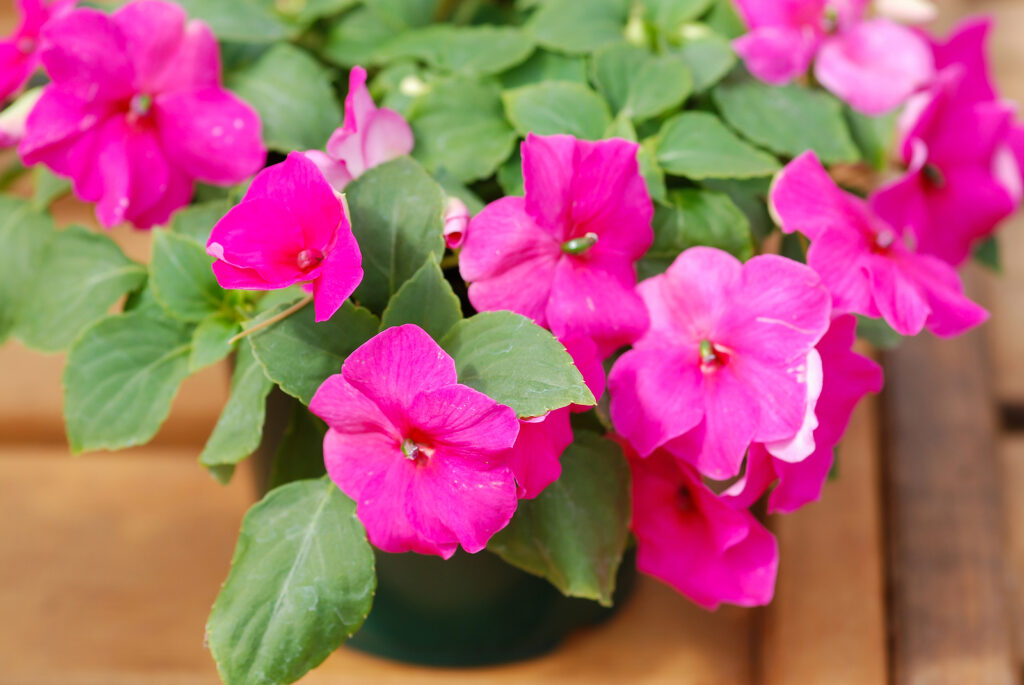
Get to know Impatiens
- Plant type: Annual, perennial in warmest regions
- Growing Zones and range: Annual in Zones 2-11; grow as a perennial in Zones 10-11
- Hardiness: Easily killed by frost; tolerant of heat
- Height and width: 6 to 18 inches (15-45cm) tall and wide and taller, depending on the variety.
- Foliage: Brittle, almost succulent stems, and lush, fleshy, semi-translucent leaves
- Flowers: Single or double blossoms from 1 to 3 inches (2.5-7.6cm) wide.
- Flower colors: brightly colored white, peach, pink, rose, red, fuchsia, lilac, or orange; some flowers are bi-colored
- Bloom time: Spring through fall frost
- Uses: Shade garden, containers, hanging baskets
- Common name: Impatiens
- Botanical name: Impatiens and hybrids—see below
- Family: Balsaminaceae
- Origin: Damp habitats throughout tropical and warm temperate regions
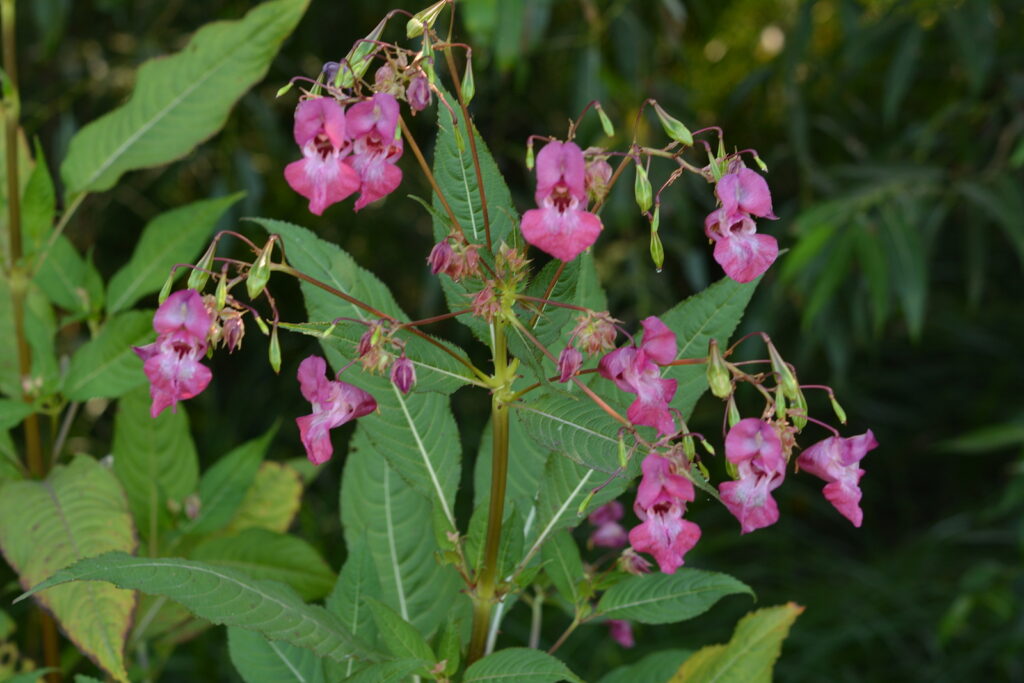
Where to plant Impatiens
- Plant impatiens in light shade in Zones 2-5. Plant in deep shade in hot-summer regions in Zones 6-11.
- Grow impatiens in humus-rich, well-drained soil.
- Impatiens prefer a soil pH of 6.5 to 7.5.
Impatiens uses
- Impatiens provide mounds of bright color in shady beds and borders.
- Use Impatiens as edging in shaded borders.
When to plant Impatiens
- Set impatiens in the garden in spring when all danger of frost has passed.
- Start seed indoors 8 to 12 weeks before the last frost in cold winter areas; start seed any time of the year in frost-free regions.
- Sow seed outdoors when the soil has warmed and the danger of frost has passed.
- Set plant outdoors after all danger of frost has passed.
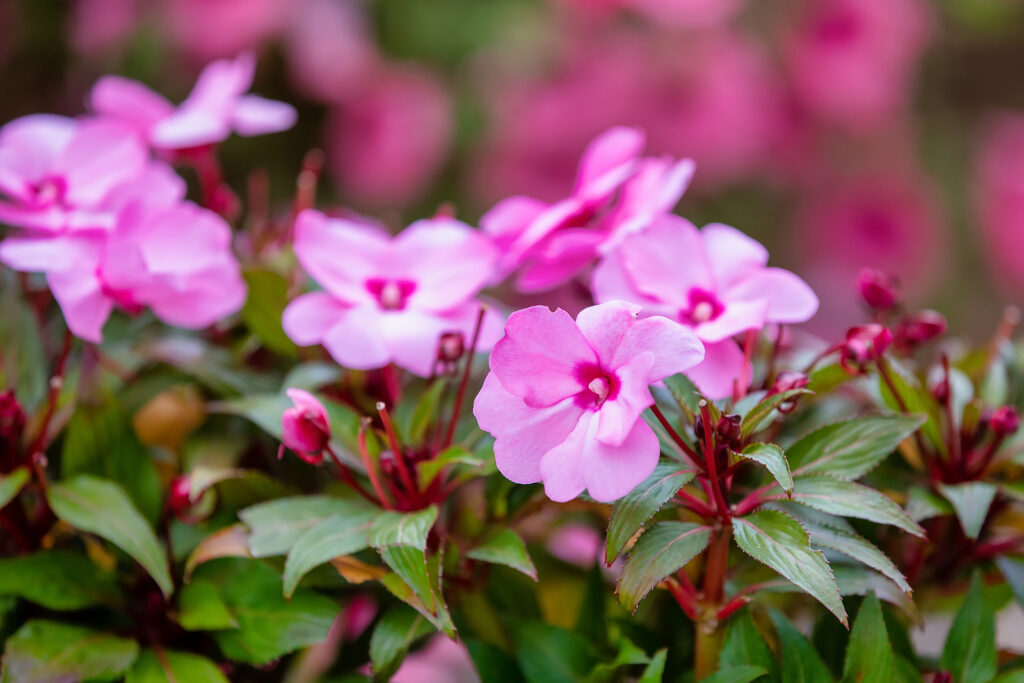
Planting and spacing Impatiens
- Sow seeds indoors in small pots, six-packs, or flats; barely cover seeds with potting mix.
- Seeds germinate in 7 to 21 days at 65° to 75°F (18°-24°C). Germinate seeds under bright light.
- Set plants outdoors in their permanent place after all danger of frost has passed. Harden off plants before setting them in the garden.
- Space impatiens 6 to 12 inches (15-30cm) apart; best planted in groups of a dozen or more.
- Naturalize impatiens by spreading seed in early spring; afterward, plants will propagate themselves.
How to water and feed Impatiens
- Keep impatiens well-watered; keep the soil evenly moist.
- Fertilize impatiens at planting time and then occasionally, about every 6 weeks with a slow-release fertilizer.
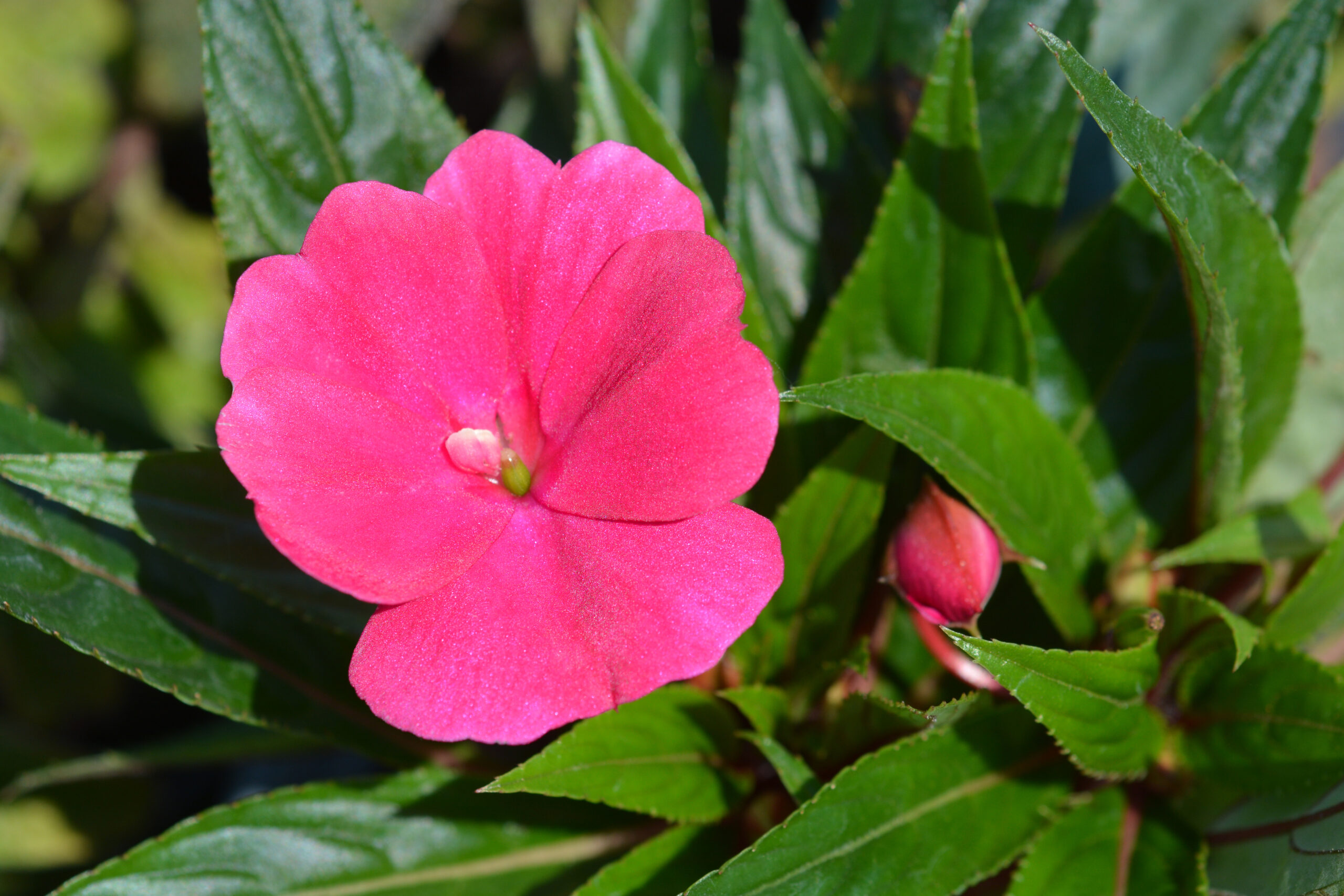
Impatiens care
- Mulch around impatiens with aged compost to conserve soil moisture.
- In Zones 10-11 grow impatiens as a perennial; cut back by two-thirds or more in spring to promote new growth.
- Pinch back the central once to stimulate side branches and bushy growth.
Growing Impatiens as a houseplant
- Impateins wallerana, busy Lizzie, can be grown as a houseplant.
- Grow Impatiens where the temperature is average, light is direct to bright and humidity is average to high.
- Grow Impatiens in a rich, well-drained, soilless medium, and keep the medium evenly moist while the plants are flowering.
- Allow the medium to dry out slightly between waterings in fall and winter.
- Fertilize monthly from spring through fall.
- Pinch back growing tips regularly to keep the plant compact.
Impatiens pests and diseases
- Impatiens can be attacked by aphids, whiteflies, and spider mites.
- Leaf spot, wilt, and root rot can occur.
Impatiens propagation
- Start seeds indoors in early spring 6 to 8 weeks before the last frost date in a shallow layer of vermiculite. The seed does not need to be covered. Set plants out when the weather warms.
- Seeds germinate in 10 to 20 days at 75° to 78°F (24°-26°C).
- Ripe seeds can be collected each summer; store seeds in a paper envelope.
- Take stem cuttings about 6 inches (15cm) long and root them in a moist potting mix or in a glass of water on a bright windowsill. New plants will root in about 3 weeks in warm weather.
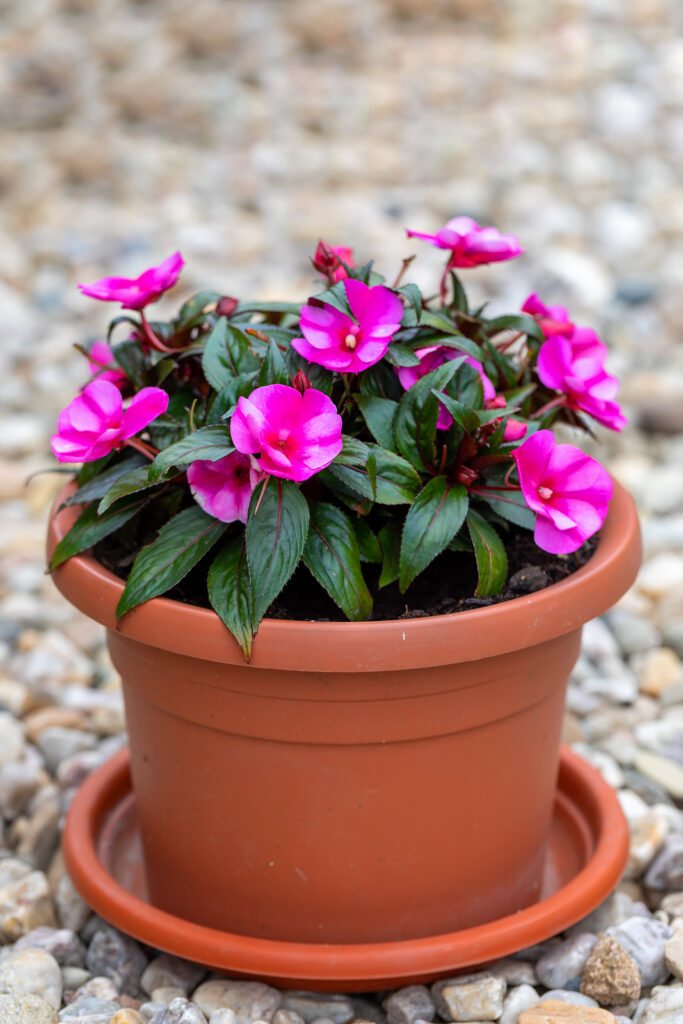
Impatiens varieties to grow
- There are hundreds of varieties of impatiens. Single and double flower varieties; double flowers look much like small roses. Colors range from magenta and violet to pink, salmon, white, and yellow.
- Impatiens balsamina, Balsam: Annual that easily self-sows and is common in gardens. Grows 2-inch (5cm) camelia-like flowers; the plant grows 10 to 30 inches (25-76cm) tall; leaves can grow to 6 inches (15cm) long; flowers appear on stems among the leaves; flowers in pink, and red, lilac, and white; a good choice to plant in masses in sun or light shade.
- I. glandulifera, Himalayan jewelweed: Annual; this species is native to the Himalayas but has been naturalized to other regions of the world; grows 12 to 36 inches (30-91cm) tall; ovate to lance-shaped leaves; bears clusters of 1½ inch (4cm) lavender to rose-purple flowers.
- I. New Guinea hybrids, New Guinea impatiens: Tender perennials developed by crossing various species from New Guinea including Impatiens schlecteri; lance-shaped dark green leaves often striped bright-colored yellow or bronze or variegated with yellow or cream; some plants can reach from 8 to 24 inches (20-61cm) tall and wide; flat-faced 2 to 2 ½ inch-wide flowers that appear summer to frost in shades of rose, red, salmon, lilac-pink, and white.
- I. wallerana, Busy Lizzie: Tender perennial is often grown as an annual. Many cultivars and sizes from 4 to 24 inches (10-61cm) tall; rounded to lance-shaped leaves are green with a bronze finish; showy flat-faced flowers, single or double, 1- to 2 ½ inches wide in colors that range from pink, dark pink, lavender, rose, white, salmon, red, and orange-red and bicolors; flowers from summer to frost. Elfin Series matures at six inches (15cm) tall.
Impatiens frequently asked questions
Q: How much shade can impatiens take?
A: Impatiens are more shade tolerant than any other annual. That said, bright light, with a few hours of direct sun, is needed for the best flowers.
Q: Can I sow impatiens seeds directly in the garden?
A: You can, but it is unlikely the seeds will have enough time to grow into flowering plants–unless you are in the tropics. The best course is to start seeds indoors 10 to 14 weeks before the last spring frost for transplanting out a few weeks after the last frost. Otherwise, purchase nursery started plants for translating into the garden.
Q: The leave of my impatiens wilt during the day even though I water them well. Why?
A; Impatiens want moist soil. It is not uncommon for impatiens to wilt when the weather is hot. Mulch around the plants to retain soil moisture and keep the soil cool.
Q: My impatiens have grown tall and lush, but they have no flowers. What’s wrong?
A: You have probably overfertilized them. Fertilize impatiens lightly early in the season and then not again during the growing season.
Q: How do I care for impatiens indoors?
A: Impatiens make excellent everblooming house plants provided they can be grown fairly cool, not warmer than 65°F. They also need humidity greater than 40 percent. Set pots on pebble-filled saucers of water –this will promote humidity. If long bare stems develop, cut them all the way back. Do not let the soil dry out or the leaves will yellow. Place impatiens where they get bright light.
Q: Can I dig up impatiens from my garden and get them to bloom indoors in winter?
A: Yes, if you prepare them for the move. Pot them carefully in early September. Set them in a shaded, sheltered place outdoors for a couple of weeks. Then bring them indoors to a spot with good air circulation and bright light. Keep the soil just moist and provide the necessary humidity–40 percent. With proper care, they will bloom enthusiastically indoors.
Q: What is the sticky substance on my impatiens?
A: This is likely honeydew, the excrement of aphids or scale insects. Locate the pests and control them with insecticidal soap or horticultural oil.
Related Articles:
- 20 Perennials That Bloom for 6 to 8 Weeks
- Shrubs with Showy Flowers Season-by-Season
- Trees in Garden Design
- Growing Annuals for Summer Bloom
- Trees—click here for more articles
- Shrubs—click here for more articles
- Perennials—click here to see more
- Annuals—click here to see more















